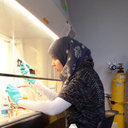Antimicrobial, Antioxidant, and Cytotoxic Activities of Ocimum forskolei and Teucrium yemense (Lamiaceae) Essential Oils.
Açar sözlər
Mücərrəd
Background:Ocimum forskolei and Teucrium yemense (Lamiaceae) are used in traditional medicine in Yemen. Methods: The chemical composition, antimicrobial, antioxidant and cytotoxic activities of the essential oils isolated from the leaves of Ocimum forskolei Benth. (EOOF) and two different populations of Teucrium yemense Deflers., one collected from Dhamar province (EOTY-d), and another collected from Taiz (EOTY-t) were investigated. The antimicrobial activities of the oils were evaluated against several microorganisms with the disc diffusion test or the broth microdilution test. The essential oils were screened for in-vitro cytotoxic activity against human tumor cells. EOOF and EOTY-d were screened for free-radical-inhibitory activity using the DPPH radical scavenging assay. Results: Sixty-four compounds were identified in (EOOF) representing 100% of the oil content with endo-fenchol (31.1%), fenchone (12.2%), τ-cadinol (12.2%), and methyl (E)-cinnamate (5.1%) as the major compounds. In EOTY-d, 67 compounds were identified, which made up 91% of the total oil. The most abundant constituents were (E)-caryophyllene (11.2%), α-humulene (4.0.%), γ-selinene (5.5%), 7-epi-α-selinene (20.1%), and caryophyllene oxide (20.1%), while the major compounds in EOTY-t were α-pinene (6.6%), (E)-caryophyllene (19.1%) α-humulene (6.4%), δ-cadinene (6.5%), caryophyllene oxide (4.3%), α-cadinol (9.5%), and shyobunol (4.6%). The most sensitive microorganisms for EOOF were B. subtilis, S. aureus, and C. albicans with inhibition zones of 34, 16, and 24 mm and MIC values of, 4.3 mg/mL, 4.3 mg/mL, and 8.6 mg/mL, respectively. EOTY-t showed antimicrobial activity against S. aureus, B. cereus, A. niger, and B. cinerea with MIC values of 0.156, 0.156, 0.313 and 0.313 mg/mL, respectively. Neither essential oil showed remarkable radical inhibition (IC50 = 31.55 and 31.41 μL/mL). EOTY-d was active against HT-29 human colorectal adenocarcinoma cell lines with IC50 = 43.7 μg/mL. Consistent with this, EOTY-t was active against both MCF-7 and MDA-MB-231 human breast adenocarcinoma cells. Conclusions: The antimicrobial activity of Ocimum forskolei essential oil against B. subtilis and C. albicans is consistent with its traditional use in Yemeni traditional medicine to treat skin infections. Both O. forskolei and T. yemense show wide variations in their respective essential oil compositions; there remains a need to investigate both species botanically, genetically, and phytochemically more comprehensively.




